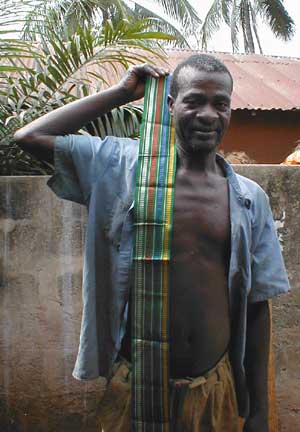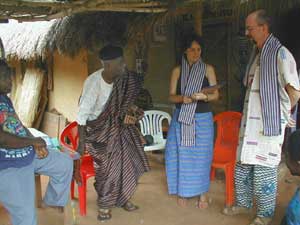Dale Massiasta
Director
Blakhud Research Center
Before April 2001, when Luciano Ghersi,
Weaver of the Century, enrolled at the Black Humanity Development
Research (Blakhud) Centre
in Klikor to study the Ewe loom and kete, many students in Ghanaian
training colleges and universities especially had studied under
me kete weaving in general, touching on warp-making, designing
kete, marketing and the history of traditional handicrafts. Most
students were then interested in the yarn industry, the most
lucrative local business area. But where the bustles of the few
kete markets attract socio-economic value studies of traditional
handicrafts, so little has been devoted to the study of the great
handweavers and their products, the significance of the designs,
motifs and quality. Nothing has been studied about the cloths
that recorded history or even made history. Most of these student-study
projects ended up on the dirty shelves. They were essentially
academic exercises with very little impact on promoting traditional
handweaving. None of these students had actually sat in a loom.
However, the Afevo probed of Luciano Ghersi, the result of his
experiences in Klikor, from my point of view, is aimed at redefining
the importance of such exercises in practical and preserving
ways. To promote the art, it is also necessary to disseminate
information on the different aspects of handweaving techniques,
cloth designs and image representations. There is this salient
realization in Luciano's project that kete is not only to be
worn as fashion, appreciated and admired, but is also to be fitted
into the social fabric of cultural identity, an expanding history,
a barrier-breaking phenomenon with potentials for adoptions and
adaptions In other cultures. Luciano's other objective is to
create the spectrum for the larger world of Afevo, to introduce
what is essentially quality to other domains of art. So that
kete can also speak Italian or German to be understood by Italians
or Germans. In Nigeria,
for example, it speaks both Yoruba and Ewe, where Ewe handweavers
there are producing culture barrier-breaking products. A few
of these products form part of this project collection. Luciano
may, however, be compelled to investigate the field further in
Nigeria among Ewe handweavers there. His present task of documenting
Afevo meaningfully Will certainly lead to this field.
Luciano's first task is to create e web-site for his special
field, Afevo and draw the world's attention to this ancient Ewe
art. This is possibly miles ahead of my own personal efforts
to preserve a "dying art among the Ewe at home". For
the sake of recapturing the moments of my own involvement in
the art between 1965 and 1978, when I hanged my heddles and reeds,
I kept a few kete warp-making tools, kete pieces or samples in
the Blakhud Museum. And these include damaged or mouse-gnawed
shuttles and reeds, a tedious warp-making apparatus (KOKLOE),
some Afevo pieces, etc. I am, however, proud of a soiled one-foot
long piece of a grandfather who died in 1942 and reincarnated
in me! This piece was probably woven in 1910. But how careless
I had been in 1989 to accidentally burn my father's AFA oracular
bag made with some pieces of my first kete cloth woven in 1985.
Earlier in 1979, I had not realized the importance of bringing
back to Klikor heddles and reeds my father used in exile in Togo
in 1953. For several months that I had stayed in Agoenyive in
Togo in 1978-1979, I had seen my fathers heddles and reeds hang
on a wall of the hut in which he had lived in Agoenyive for the
three years of exile. Returning In 1980 to plunge into writing
about politics and literature, memories of the great art of weaving
were only temporarily revived when the students mentioned earlier
sought my help to write their long essays on traditional strip-cloth
weaving. Luciano was to revive my memories of the art that dates
from the origins of time.
The 1940s and 1950s especially was a period In which both the
performing arts and kete weaving as a handicraft achieved their
greatest popularity and promotion. There was the music competitions
of rival drumming groups, which ordered Afevo kete in particular
for various purposes. New songs had to be translated in cloth
images, the invincibility of performing groups had to be depicted
in cloth designs. Particular types of cloths
had to be used to outdoor new groups, and the more expensive
or less expensive ones would determine a hard-working group or
a less hard- working one. There was also the shrine festivals
highlighted by drumming and dancing. The initiates must display
their wealth of intricately woven Afevo, of beads and of jewelry.
the art of weaving was at its best during the period. No doubt
that my father, Lumor Azameti, had a loom in Togo after running
away from the Land Poll crisis of 1953. I visited him as an eight-month-old
baby.
The Afevo in particular was then a sacred cloth. Its quality
was protected because it was what the weaver himself/herself
could preserve and cherish among his/her treasures of kete. (Any
other could be dumped in the market). Its meaning and purpose
must be assessed by other connoisseurs. It was in it that the
quality and design of the warp was emphasized, that the images
depicted could be read and understood. It was In the Afevo that
the appearance of both the warp and weft mattered. It was in
it that rules were established: the cloth must not fade, it must
be worn comfortably, it must have e message, a story, a proverb,
an occasion. Even if it was plain weave, the motif, the combination
of warp colors must be attractive enough to conjure a name, to
fit into an occasion. The quality
must create the name of the cloth: Oh what a cloth! I just
envy its imposing and attracting character! "Woha TSI NATA",
that is, "You also make it and wear" is a reply
from the cautious wearer and weaver. Yes TSINATA, the cloth,
become a favourite of the Ewe students of the then Achimota College,
Accra, whose imported sandals also became ACHIMOTA SANDALS. The
cloth, TSINATA, an Afevo, takes the name of ACHIMOTA
to this day.
Luciano also takes up this task of cataloguing the names of the
cloths and the meanings behind the common images and symbols
in the cloths. I presently have an old silk cloth - an Afevo
because of its quality, refinery, art and wearer - which has
an image of a covered calabash put on a stool. The symbolism
of this image may appear simple enough. But here, a whole religion
is embossed in art, in a strip or stole of cloth. Therefore,
Luciano has not only joined the great guild of kete weavers,
but he has also embarked on the task of unfurling the mystic
meanings of religious symbols, the solemnity of the sacrifices,
practices and the liturgies embossed in fabric. Afevo in particular
is a surviving testimony of the culture and history of the Ewe
people.
Dale Massiasta
Blakhud Research Centre
Klikor, February 2002
|
Luciano Kwame Ghersi
Research Assistant
Blakhud Research Center

The weaver Solakpa
A. Fiamavor Azameti
with one of his Anyievo cloths (see also:
065)
Klikor, Nov. 2001
Introduction to AFEVO
CATALOG
"AFEVO: Home Handweave of the Ewe" is a research focused
on the textile collection of the Blakhud Museum of Klikor (V/R,
Ghana). These albums are a step of the AFEVO project, that's
active since April 2001.
The first step of AFEVO was performed by many traditional kete-weavers
of Klikor, who decided to donate samples of their own cloth to
Blakhud Museum.
Exactly 100 pieces were listed, simply following the number of
their own digital photo. Cloth name, weaver's name, year of production,
meaning and history were also recorded, when possible. All the
photos and informations about the 100 pieces were immediately
uploaded on Internet at the Web URL http://www.hypertextile.net/afevo . Images
of a detail of each piece were also put on-line. Images of back-sides
were only uploaded when interesting.
The most peculiar web-publishing of AFEVO is probably the VIRTUAL-STITCH TOUR:
that gives a survey of the cloths as they were stitched together.
That's indeed the real target of any kete weaving, as the rytme
of these woven strips is fully displayed only when "Single
becomes Pattern." So that, beyond any value in visual or
cyber arts, this "Virtual Stitch Tour" may also be
a suggestion to recognise links between weaving, music, dance
and (obviously) religion in Ewe culture...
The whole AFEVO web-site is also available in the AFEVO CD-rom,
that was presented at the first world AFEVO exhibition. This
anti-prèmière exhibition, together with performances
of kete weaving, happened at the yearly convention of handweaving
"Filo lungo Filo", held in Italy (Leumann, TO) on Sept
- Oct. 2001 (reported on Tessimilia).
The AFEVO project is also reported on "TessereAmano",
the italian magazine of hand-weaving (Nr. 3/2001, http://www.geocities.com/tessereAmano).
AFEVO is also quoted on Jacquard , the magazine of Lisio Foundation
of Silk Art - Florence (Nr. 47/2001). The first course of kete-weaving
in Italy was held at the same Lisio Foundation on Oct. 2001 (see
at: http://www.fondazionelisio/org)
These albums contain the 100 formerly listed pieces and also
furtherly collected pieces. The whole description of each piece
is here still missing, as, before printing, it requires to be
revised by Dale Massiasta, Director of Blakhud Research Center.
Some prints of previous AFEVO Web-pages are here given as an
example.
Further steps of the AFEVO projet will be:
- the detailed analysis of the cloths
the description of different tecniques
- a glossary of the Ewe terms of weaving,
- the substitution of the previous Web-
and CD-rom images by more definited scanned images
- the publishing of a book as catalogue
of
- the first whole exhibition of "AFEVO:
Home Handweave of the Ewe".
Luciano Kwame Ghersi
Weaver of the Century
Klikor, Nov. 2001

AFEVO Celebration at Blakhud Museum
Director Dale Massiasta, HM Togbui Addo VIII of Klikor,
Eva Aku Basile, Luciano Kwame Ghersi
Klikor, Nov. 18th 2001
|


